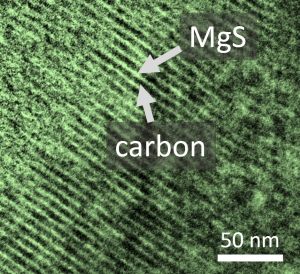In many electrical devices, lithium-ion and metal-hydride batteries are applied for energy storage. Scientists are also studying alternatives to these established battery systems in order to enhance the safety, cost efficiency, sustainability, and performance of future devices. It is their objective to replace lithium by other elements. For this purpose, all battery components have to be newly developed and understanding of electrochemical processes is required.
Magnesium-based battery cells are presently considered an attractive option to replace lithium in batteries. In principle, magnesium allows higher storage densities to be reached than lithium. Other advantages of magnesium are its high abundance in nature, its non-toxicity, and its low degradation in air in contrast to lithium. So far, progress achieved in this area has been limited. For the design of magnesium batteries of high storage capacity and power density, suitable electrolytes are needed that can be easily to produced, that are stable, and can be used in high concentrations in different solvents.
At the HIU, a research team headed by Maximilian Fichtner and Zhirong Zhao-Karger has now presented a new promising electrolyte, which might allow for the development of an entirely new generation of batteries. The new electrolyte is characterized by a number of promising properties. It possesses an unprecedented electrochemical stability window and a very high efficiency. In addition, the electrolyte can be used in various solvents and at high concentrations. Moreover, the electrolyte is chemically compatible with a sulfur cathode, which can be discharged at a voltage close to the theoretical value.
Another advantage is the very simple production of the electrolyte. “Two commercially available standard chemicals, a magnesium amide and aluminium chloride, are applied. They are added to the solvent desired and subjected to stirring. This simple mixture can then be used directly as an electrolyte in the battery.”, Maximilian Fichtner says.
Zhirong Zhao-Karger, Xiangyu Zhao, Di Wang, Thomas Diemant, R. Jürgen Behm, and Maximilian Fichtner: Performance Improvement of Magnesium Sulfur Batteries with Modified Non-Nucleophilic Elec-trolytes. Advanced Energy Materials. Article first published online: 6 OCT 2014. DOI: 10.1002/aenm.201401155
About the Helmholtz Institute Ulm (HIU)
The HIU was established in January 2011 by KIT, member of the Helmholtz Association, in cooperation with Ulm University. With the German Aerospace Center (DLR) and the Center for Solar Energy and Hydrogen Research Baden-Württemberg (ZSW), two other renowned institutions are involved in the HIU as associated partners. The international team of about 110 scientists at HIU works on the further development of the fundamentals of viable energy storage systems for stationary and mobile use.
In close partnership with society, KIT develops solutions for urgent challenges – from climate change, energy transition and sustainable use of natural resources to artificial intelligence, sovereignty and an aging population. As The University in the Helmholtz Association, KIT unites scientific excellence from insight to application-driven research under one roof – and is thus in a unique position to drive this transformation. As a University of Excellence, KIT offers its more than 10,000 employees and 22,800 students outstanding opportunities to shape a sustainable and resilient future. KIT – Science for Impact.

